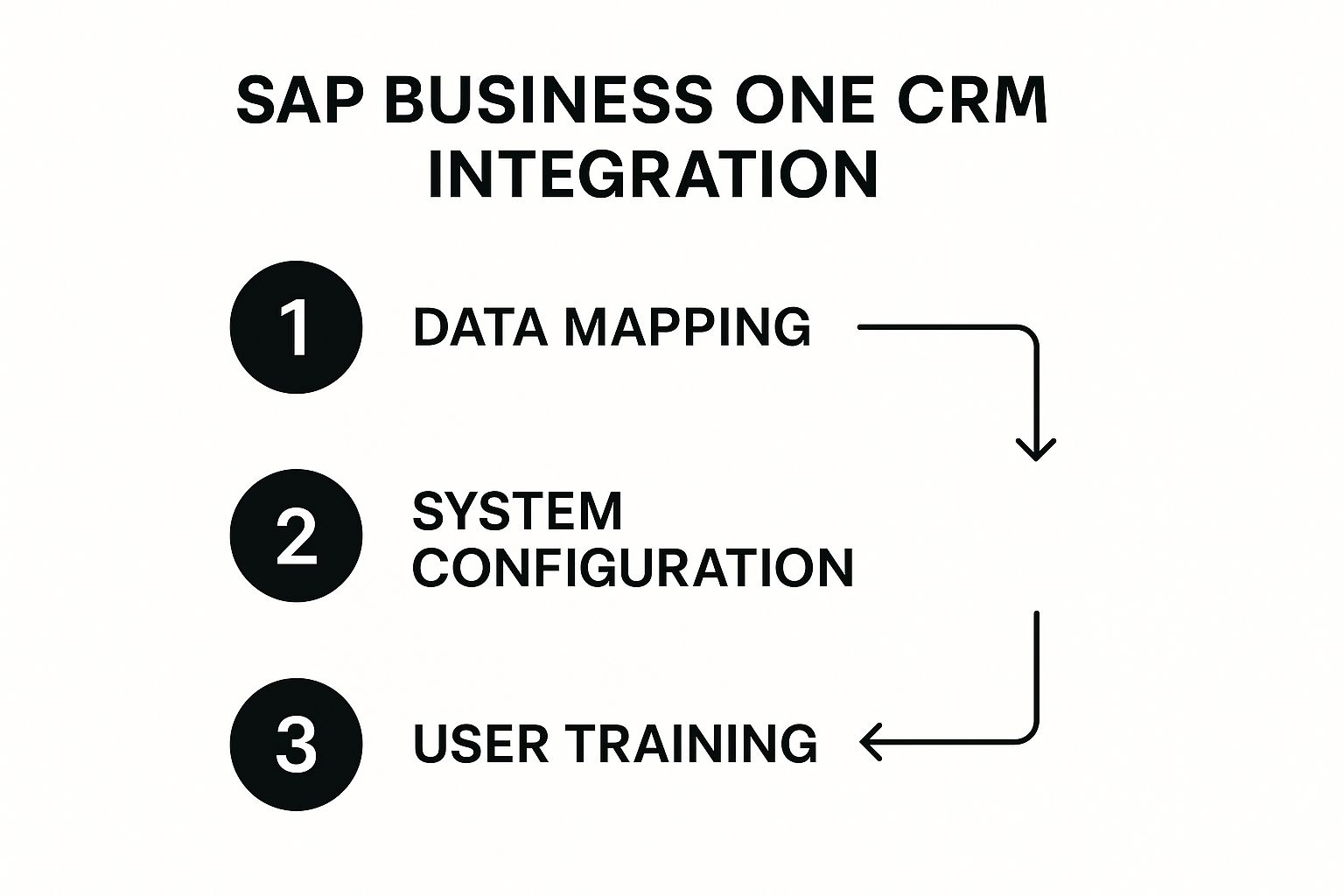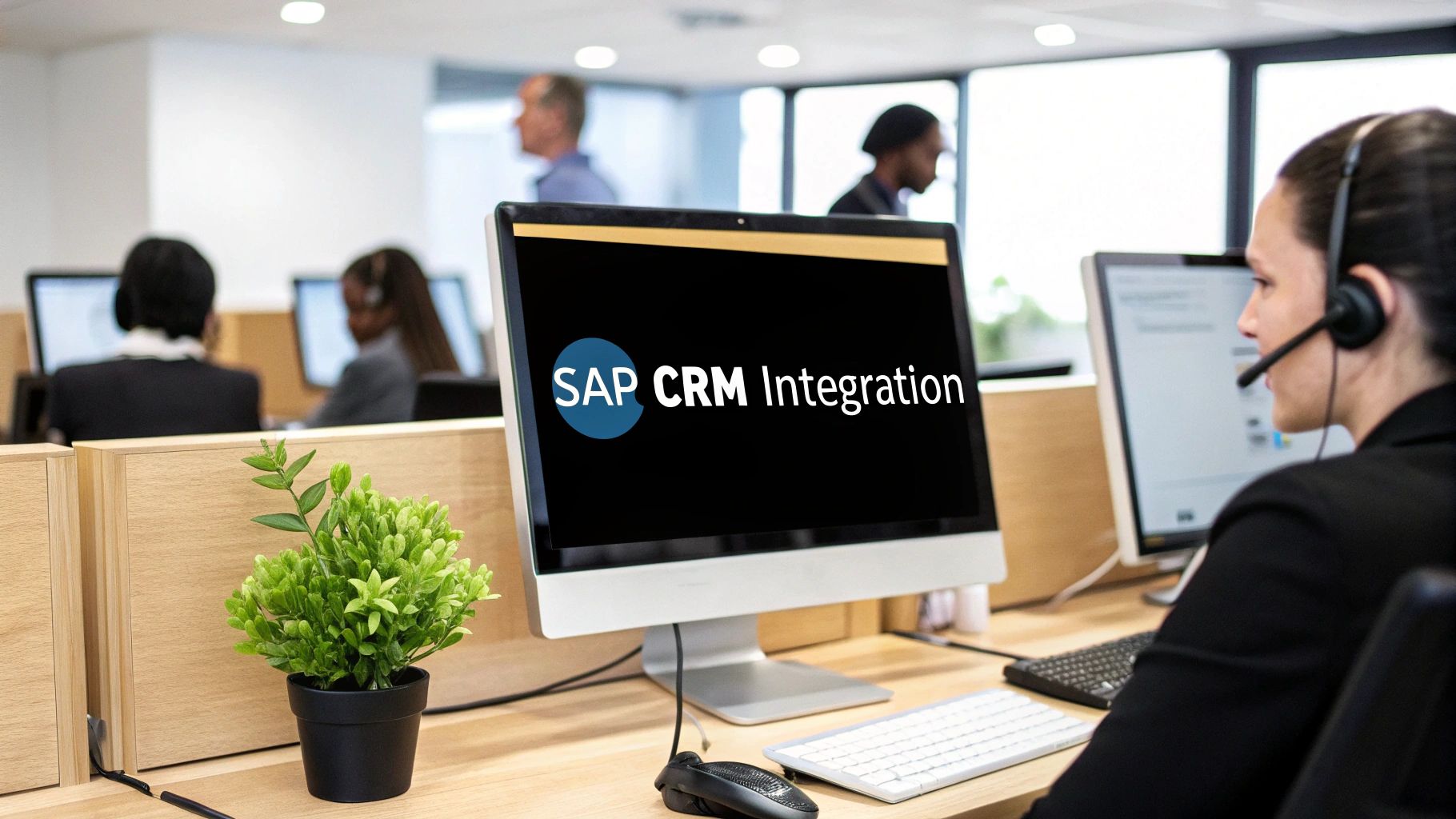Connecting SAP Business One with your CRM and contact center isn't just a technical tweak—it's a fundamental shift in how your business operates. It’s about tearing down the walls between your finance, sales, and service departments to build a single, powerful view of every customer interaction.
Why SAP Business One and CRM Integration Drives Growth
When your core systems, like SAP Business One and your CRM, live on separate islands, you're creating friction. Your teams are constantly toggling between screens, hunting for information, and working with an incomplete picture of the customer. It’s inefficient and frustrating.
A proper SAP Business One CRM integration solves this by creating a single source of truth. Data flows freely between the platforms, keeping everything in sync. Think about it: a sales rep can pull up a client’s complete payment history from SAP B1 right inside their CRM dashboard, moments before a crucial call. That’s the kind of context that closes deals.
Fostering Smarter Decisions with Unified Data
When everyone has access to the same real-time data, your teams can make much sharper decisions.
Let's look at some real-world examples:
- Your sales team can spot prime upsell opportunities by looking at a customer's purchase history and current credit status. No more guessing.
- A service agent can resolve a support ticket in one touch by seeing order details, shipping status, and invoice information—without ever needing to ping someone in finance.
- The finance department gets a crystal-clear view of the sales pipeline, which makes cash flow forecasting far more accurate.
This shift moves your business from being reactive to proactive. Instead of just responding to customer needs as they pop up, you can start anticipating them. This is especially vital in competitive markets. In the United Arab Emirates, for instance, businesses with these integrated solutions have seen customer retention rates climb by up to 25% simply because they have better data and can respond faster. You can dig into a full study about SAP and CRM integration benefits on simply-crm.com.
Streamlining Operations for Maximum Efficiency
Let’s be honest, manual data entry is a drain on resources and a breeding ground for expensive mistakes. An integrated system automates the whole process, which has a direct impact on your bottom line.
Imagine this: a new sales order is created in your CRM. That order can instantly and automatically generate a corresponding entry in SAP B1. This simple connection cuts out duplicate work, slashes the risk of human error, and dramatically speeds up your entire order-to-cash cycle.
This automation isn't just about sales orders; it can touch every part of the customer journey. For example, looking into how a WhatsApp CRM integration can centralize conversations shows the power of having a truly unified customer view. The goal is always to build a seamless workflow where technology serves your business, not the other way around.
To get a clearer picture of these gains, let's break down the immediate advantages.
Immediate Benefits of an Integrated SAP B1 and CRM System
| Operational Area | Benefit of Integration |
|---|---|
| Sales | Access to real-time inventory and customer credit status directly within the CRM. |
| Customer Service | Single-screen access to order history, shipping details, and invoices for faster issue resolution. |
| Finance | Automated invoicing from CRM sales data and improved cash flow forecasting. |
| Operations | Reduced manual data entry, minimized errors, and a faster order-to-cash cycle. |
| Leadership | Comprehensive, 360-degree view of customer data for strategic planning and decision-making. |
Ultimately, by connecting these essential systems, you’re not just improving efficiency—you’re creating an environment built for scalability and sustainable growth.
Discover more about our available CRM integrations at Cloud Move and see how we can connect the tools that run your business.
Laying the Groundwork for a Seamless Integration

A successful SAP Business One CRM integration doesn't kick off with code; it begins with a solid strategy. From my experience, the costliest mistakes don't happen during development. They stem from a lack of clear direction and proper planning right at the start. Jumping into the technical work without this foundation is like building a house without a blueprint—you’re just asking for frustrating delays and expensive rework down the line.
The very first thing to do is get your project team in place. This isn’t just an IT job. To make sure the final solution actually works for the whole business, your team needs to be cross-functional.
You absolutely need voices from these key areas:
- Finance and Operations: These are your SAP B1 experts. They live and breathe everything from invoicing and inventory to financial reporting, and their input is critical for maintaining data integrity.
- Sales and Customer Service: As the people who will use the CRM and Cloud Move platform every day, their perspective is non-negotiable. They know what a practical workflow looks like to close deals and support customers effectively.
- IT and Technical Staff: This group handles the technical heavy lifting. They’ll assess the integration architecture, ensure it's secure and scalable, and manage the hands-on implementation.
Bringing these stakeholders together from day one is the only way to align expectations and break down the very silos this integration is meant to fix.
Conducting a Thorough Data and Workflow Audit
With your team assembled, it's time to get your hands dirty and figure out exactly what you're working with. This means taking a deep look at both your data and your current business processes. You need to map out precisely what information has to travel between SAP Business One and your telephony platform.
Start by asking the tough questions:
- What specific customer details from the CRM are needed in SAP B1 to generate an invoice correctly?
- How can we make inventory levels from SAP B1 visible to the sales team inside the CRM in real time?
- When a new sales order is created in the CRM, what should that trigger inside SAP B1?
This process of mapping data fields—like linking a "Business Partner" in SAP to an "Account" in the CRM—is fundamental. It's also the perfect opportunity to clean up your data. Dealing with duplicates, incomplete records, and other inconsistencies now will prevent a world of pain later. Following established data integration best practices is essential here for building a system that’s accurate and can grow with you.
A rookie mistake I see often is the attempt to sync everything. Don't. Instead, focus on the data that drives action. Prioritize based on business impact. For instance, real-time stock levels are probably far more critical for your sales reps than historical marketing data from two years ago.
Setting Clear and Measurable Integration Goals
Finally, you need to define what a "win" looks like in concrete terms. Vague goals like "improving efficiency" are useless. Your objectives have to be specific, measurable, achievable, relevant, and time-bound (SMART). This clarity gives the project focus and a yardstick to measure its ultimate ROI.
Think in terms of tangible outcomes. Here are a few real-world examples of strong goals:
- Reduce manual data entry between our sales and finance teams by 40% within six months of go-live.
- Decrease the average order processing time from 48 hours down to 24 hours in the first quarter post-launch.
- Achieve a 99% match rate for customer records between SAP B1 and the CRM to improve data accuracy.
- Cut down on sales-to-operations queries by at least 15% by giving reps instant access to inventory levels.
Setting clear targets like these elevates the project from a technical task to a core business initiative. It gives your team a clear destination and ensures your SAP Business One CRM integration delivers real, quantifiable value.
A Practical Guide to Putting Your Integration on the Rails
Alright, let's get down to brass tacks. Moving from a well-thought-out plan to a live, working system is where the real magic happens with a SAP Business One CRM integration. This is the hands-on, technical part of the project where your strategy becomes a reality, directly impacting how your teams work every day. While a platform like Cloud Move definitely smooths out the process, getting these core steps right is essential for a successful launch.
The very first thing you need to do on the technical side is establish a secure handshake between your systems. This means configuring API authentication. Think of it as a tightly guarded digital key that lets SAP B1, your CRM (whether it's Salesforce, Zoho, or something else), and the Cloud Move telephony platform talk to each other securely. It’s a private bridge that ensures only authorized data can get across.
Mastering the Art of Data Field Mapping
Once your systems are connected, you’ll hit the most critical and detail-oriented phase: field mapping. This is where you essentially create a translation dictionary, telling your systems what "means what" across platforms. If you rush this or get it wrong, you’re setting yourself up for data chaos and broken processes down the road.
For instance, a ‘Business Partner’ in SAP Business One has to map perfectly to what your CRM calls an ‘Account’ or ‘Company’. That ‘Sales Order’ in SAP? It needs to be directly linked to the ‘Deal’ or ‘Opportunity’ record that kicked it off in the first place.
Here are a few real-world examples I see all the time:
- Customer Information: Mapping the
BP Codein SAP to theAccount IDin your CRM is fundamental. It ensures you’re always looking at the same customer record in both places. - Sales Data: You need to align the
Item CodeandQuantityfrom a CRM’s product list directly with the corresponding fields in an SAP B1 sales order. No guesswork allowed. - Financial Status: A great move is to link the
Account Balancefield in SAP to a custom ‘Current Balance’ field in the CRM. This gives your sales reps instant, critical visibility without ever leaving their primary tool.
Nailing these mappings from the get-go is the foundation for maintaining clean, reliable data across your entire tech stack.
This next flow chart gives you a bird's-eye view of the whole project, from mapping data right through to training your teams.

As you can see, the technical setup is just one piece of the puzzle. It has to be followed by smart configuration and empowering your people to actually use the new system effectively.
Configuring Your Data Synchronization Rules
With your fields mapped, the next big question is: how and when should data move? This is where you define the rules of engagement by setting up synchronization rules and triggers that fit your business rhythm.
You generally have two main approaches here:
- Real-Time Sync: Data updates get pushed instantly. A sales rep updates a customer’s phone number in the CRM, and poof—it’s updated in SAP Business One. This is perfect for time-sensitive info like stock levels or contact details.
- Batch Sync: Data updates happen on a schedule, like every hour or just once overnight. This is better for less urgent data or huge volumes, like syncing daily sales reports, as it prevents bogging down your systems during busy hours.
You also need to set your triggers—the specific events that kick off a data transfer. A classic example is when an opportunity stage is changed to ‘Closed-Won’ in your CRM. That action can automatically trigger the creation of a sales order and invoice in SAP Business One.
My personal advice? Go with a hybrid model. Use real-time sync for the critical, customer-facing data your sales and service teams need right now. For backend financial reconciliation or bulk data jobs, stick with batch updates to keep everything running smoothly.
The Importance of Sandbox Testing
Before you even think about going live, you absolutely must test everything in a sandbox environment. This is a non-negotiable step. A sandbox is a safe, isolated copy of your live system where you can push, pull, and break things without any risk to your actual business operations.
This is your chance to run through entire workflows from start to finish. Simulate creating a lead, converting it into a customer, processing an order, and generating an invoice. You'll see exactly how the data flows at each step. It’s during this phase that you’ll catch those pesky configuration errors, mapping mistakes, or workflow bottlenecks before they can cause real headaches for your customers or your finance team. This is how you ensure a smooth, predictable launch day.
Across the UAE, the impact of SAP Business One CRM integration is becoming clear, especially in the demanding e-commerce world. We've seen local retailers achieve a reduction of backorders by approximately 15% and a 10-12% improvement in order fulfillment speed. By automating the flow from a CRM quote to an SAP B1 order, they've also cut operational costs by up to 8%. You can dive deeper into these impactful SAP integration findings on dckap.com.
Keeping Your Integrated System in Peak Condition

Getting your SAP Business One CRM integration live is a fantastic achievement. But the real work—and the real payoff—begins now. To get lasting value from this setup, you need to actively manage it. Without ongoing attention, even the best integration can slowly lose its edge, leading to messy data and frustrated users.
Think of it like a high-performance car. You wouldn’t just drive it off the lot and never check the oil or tires. Your integrated system needs the same kind of care: clear rules of the road, skilled drivers, and a watchful eye on the dashboard.
Create a Rock-Solid Data Governance Policy
If there's one thing I've seen make or break an integration's long-term health, it's data governance. This isn't just some dusty IT document; it's a practical business agreement. It clearly states who owns what piece of data and who is responsible for keeping it clean across every platform.
When information flows between SAP Business One, your CRM, and Cloud Move's platform, it’s easy for wires to get crossed. A good governance policy eliminates that confusion.
It needs to answer some very specific questions:
- Who creates new customer records? Is that a sales task in the CRM, or does it start with the finance team in SAP?
- What's the protocol for fixing a mistake? Say there's a typo in an address or a duplicate contact—who fixes it, and where?
- Which system is the final authority? For a customer’s credit limit, is SAP the source of truth? For their main phone number, is it the CRM?
Defining these rules from the outset prevents the finger-pointing that happens when data gets messy. It gives everyone a clear playbook for maintaining a single, reliable version of the truth.
A strong data governance policy is your first line of defence against data chaos. It ensures that the information your teams rely on—from sales forecasts to customer service histories—is consistently accurate and trustworthy across the entire business.
Continuously Train and Empower Your People
A new tool is only as good as the team using it. A one-off training session at launch is not enough. To get real adoption and mastery, your people need ongoing support that connects the dots between the technology and their day-to-day goals.
The most effective training I’ve seen goes beyond the "how" and focuses on the "why." Don't just show a sales rep how to pull up an SAP B1 order history in their CRM screen. Explain why having that info instantly helps them sound more informed, anticipate questions, and ultimately close more business.
Here are a few ideas that work well:
- Regular “Lunch and Learns”: Quick, informal sessions are perfect for showcasing a new feature or highlighting a specific workflow, like using Cloud Move's click-to-dial to boost outbound efficiency.
- Role-Specific Workshops: A finance user cares about different things than a contact center agent. Tailor your training to solve the specific problems each role faces.
- A “Champions” Program: Identify the power users in each department. These are your go-to people who can provide peer support, share tips, and champion best practices from within the team.
When your team truly gets how the integration makes their jobs better, they’ll stop seeing it as just another piece of software and start seeing it as an essential part of their success.
Monitor and Maintain Your System Proactively
You can't fix what you can't see. Establishing a routine for monitoring and maintenance is non-negotiable for catching small hiccups before they snowball into major headaches. A huge part of managing your SAP Business One CRM integration is being the first to know when something’s wrong.
Set up automated alerts for mission-critical failures. For instance, if a sales order from the CRM fails to sync and create an invoice in SAP B1, you need to know immediately—not when an unhappy customer calls asking where their shipment is.
Perform regular health checks to review API performance, check sync logs, and spot-check data for accuracy. This hands-on approach builds confidence, keeps the system stable, and ensures your integrated ecosystem can handle whatever your growing business throws at it.
Giving Your CRM a Voice: Supercharging It with Integrated Telephony

Connecting your data is the first step, but making that data actionable is where the real magic happens. This is where your SAP Business One CRM integration transforms from a background process into a competitive weapon. When you layer Cloud Move’s telephony and contact center platform over your unified SAP and CRM data, you create a system where every single interaction is smarter, faster, and more informed.
Suddenly, it’s not just about making calls anymore; it’s about having truly meaningful conversations.
The most immediate win you'll see is a dramatic boost in team productivity. Think about all the small, time-sucking tasks that add up throughout the day. With a feature like click-to-dial, for instance, your sales team can launch calls directly from a customer record in the CRM. One click, and the call is live. That simple change removes the friction of manually punching in numbers, slashes dialing errors, and frees up your team to make more connections.
Shifting from Reactive Service to Proactive Engagement
One of the most powerful capabilities unlocked by this three-way integration is the automatic screen-pop. When a customer calls in, Cloud Move’s platform instantly recognizes their number, queries your CRM in the background, and pushes the caller’s entire profile to the agent's screen—all before they even say "hello."
This fundamentally changes the customer service dynamic. Instead of your agent starting with a clunky, "Can I have your account number, please?" they can greet the customer by name and already have their full history in view.
- Recent orders pulled from SAP B1
- Open support tickets from your CRM
- Payment status and credit limits
- Notes and recordings from past calls
Having this information on hand turns a reactive inquiry into a proactive, personalized experience. It makes your customers feel seen and valued, which is the absolute cornerstone of building loyalty that lasts.
Forging a True 360-Degree Customer View
Every phone call, email, or chat is a breadcrumb of valuable information. Your new, integrated system ensures none of it falls through the cracks. All interactions handled through the Cloud Move platform—from call logs and durations to the recordings themselves—are automatically logged against the correct customer record in your CRM.
This builds an incredibly rich, single-pane-of-glass view of the entire customer relationship. A sales manager can review call recordings for coaching. A support agent can see that a customer just spoke with a sales rep about a new product. This creates a powerful, unified view across every touchpoint, which is a core benefit of a well-designed omnichannel contact center.
Here’s a real-world scenario: A support agent gets a call about a delayed shipment. With a single glance, they see the customer’s complete order history from SAP B1, their recent contact history from the CRM, and the live call controls from Cloud Move. They can solve the problem confidently without ever having to put the customer on hold to "check with another department."
This seamless flow of information isn’t a luxury anymore; it’s quickly becoming the standard expectation from customers. We've seen firsthand in the UAE market that companies integrating SAP Business One with a high-quality CRM report up to a 20% faster order-to-cash process. Their teams have real-time access to everything from orders and invoices to payment statuses, enabling highly relevant and timely client conversations. You can dig deeper into these powerful SAP integration use cases and solutions at appseconnect.com.
To put it into perspective, here’s how specific telephony features from Cloud Move are amplified when they can tap into your SAP B1 and CRM data.
Cloud Move Feature Enhancement for Integrated Systems
This table breaks down how specific Cloud Move features get supercharged by the SAP Business One CRM integration.
| Cloud Move Feature | Benefit in an Integrated Environment | Primary User |
|---|---|---|
| Click-to-Dial | Increases outbound call efficiency by eliminating manual dialing from CRM records. | Sales Team |
| Automatic Screen-Pop | Provides instant customer context from SAP and CRM for personalized service. | Service Agents |
| Automatic Call Logging | Creates a complete interaction history by logging calls and recordings in the CRM. | All Teams |
| Integrated Call Analytics | Links call data to sales outcomes and financial data for deeper performance insights. | Team Leaders |
Ultimately, this integration ensures that the right information gets to the right person at the right time, turning your telephony system into an intelligent engine that drives better business outcomes.
Frequently Asked Questions About SAP B1 Integration
When you're considering a SAP Business One CRM integration, it’s natural to have a lot of questions. We’ve managed countless of these projects, and we find that understanding the common variables and potential hurdles right from the start makes for a much smoother journey. Let’s dive into some of the most frequent queries we get from clients just like you.
One of the first things everyone wants to know is, "How long will this take?" The truth is, it varies. A straightforward integration using a pre-built connector, especially for a business with clean data and standard processes, can be up and running in just a few weeks.
However, if your project involves custom business logic, a major data cleanup effort, or links to several other systems, the timeline can stretch out to a few months. The biggest factors are always the quality of your data, the clarity of your requirements, and the availability of your team. For most small and mid-sized businesses, a 4-to-12-week project is a solid and realistic ballpark.
What Are the Most Common Integration Challenges?
From our experience, a few key challenges pop up time and time again.
Scope creep is probably the biggest one. It's that classic situation where a project's goals keep expanding beyond the original plan, usually because the initial requirements weren't buttoned down. Your best defense is detailed, upfront planning.
Another massive hurdle is poor data quality. We've seen it all—duplicate customer records, incomplete addresses, and inconsistent formatting. These issues can bring an integration to a dead stop. This is why we always say that proactive data cleansing isn't just a recommendation; it's an absolute must for a smooth process.
Finally, you can’t overlook user adoption. If your teams aren't properly trained or don't see the real value in the new, unified system, they'll just fall back on old, inefficient habits. That undermines the entire investment you just made.
The most persistent technical issue we see is data mapping. Fields and data structures rarely line up perfectly between SAP B1 and a CRM. Meticulous planning and rigorous testing are critical to ensure that a "Business Partner" in SAP consistently and correctly becomes an "Account" in your CRM.
Can I Integrate SAP Business One with Any CRM?
The short answer is yes, almost always. The real question is how. The entire project hinges on whether your chosen CRM has a solid and accessible Application Programming Interface (API). Think of the API as the digital doorway that lets different software systems talk to each other.
There's a reason popular platforms are so common for these projects:
These industry leaders have well-documented APIs, which makes the technical work far more predictable. The connection can be made through middleware platforms like Cloud Move, custom-coded solutions, or pre-built connectors. The right approach for your business really comes down to your specific technical requirements, timeline, and budget.
What Kind of Ongoing Maintenance Is Required?
An integration isn't a "set it and forget it" project. To stay effective, it needs ongoing attention. Both SAP and your CRM provider will release software updates, and sometimes their APIs change. Without proactive management, these changes could break the connection.
This is why regularly checking sync logs is so important—it helps you catch and fix errors before they become major problems. You'll also need to review and update your data mappings from time to time, especially if you add new custom fields or tweak your business processes. A clear data governance policy is the key to the long-term health and reliability of your integrated system.
As you refine how you communicate, it's also worth understanding the impact of using omnichannels in contemporary call centres to keep enriching your customer interactions.
Ready to create a seamless connection between your SAP, CRM, and communication platforms? Contact Cloud Move today for a free demo and discover how our expert integration services can drive efficiency and growth for your business. Learn more at https://cloud-call-center.ae.




